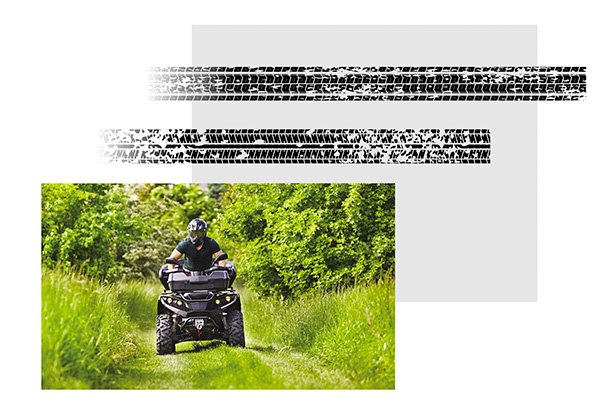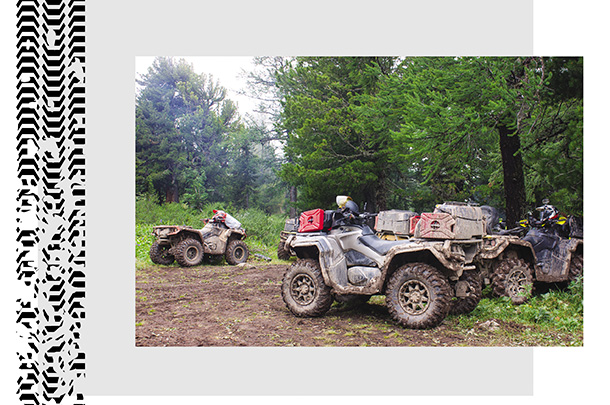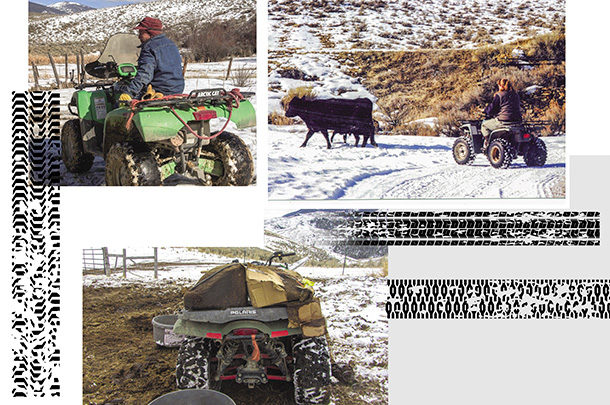Every year, many people are injured or killed in accidents involving ATVs. Most accidents occur because the ATV is not being used as intended or is ridden in an unsafe manner. Each person who rides an ATV, as driver or passenger, should follow rules for safe use.
Gary (Wes) Tracy, technician and salesperson at Wild Side Sports – an ATV dealership in Salmon, Idaho – often has customers who are new to riding ATVs. He gives advice on what type of machine might fit them and their needs, and explains safety rules and guidelines, such as using a helmet and wearing long pants. Clothing should be comfortable, but cover your body for protection if you go through brush or tumble off.
“The rider utilizes different positions to always be in balance with the machine,” he explains. You don’t want it to be overbalanced and tip over when going around a corner or up a steep hill, for instance. You must help keep the center of gravity stable. Lean forward going up a hill, and lean into the turn and not to the outside.
“Don’t ride double unless the machine is designed for a passenger. To be legal, don’t ignore age limits. There are stickers on all machines regarding age limits; you must be a certain age to be running this unit,” says Tracy. Some machines are too big and powerful for a young person to handle, and many young people don’t exercise enough caution and responsibility to ride wisely and safely.
“Even though a 15-year-old may be as big as any adult, they often don’t have the wisdom and attitude to ride safely and will try things they shouldn’t. We cannot sell a unit to a younger person,” Tracy says.
“We also want to know if they’ll be putting it in the back of a pickup to haul it somewhere to ride. The ramps for loading and unloading must be safe as well,” he says.
 Photos provided by Heather Thomas and Getty Images.
Photos provided by Heather Thomas and Getty Images.Some states have strict rules to purchase or ride an ATV. “They require that you take the state-approved safety course, and in some states you must have turn signals, mirrors and horns on your machine to be safer on back-country roads,” says Tracy. You often can’t hear a vehicle coming up behind you, especially when wearing a helmet, so it’s good to have mirrors.
Shannon Williams, University of Idaho Extension educator for Lemhi County, says the machine should fit the person riding it. A small person could have trouble handling a large or powerful machine. “People also need to realize that just because they are on an ATV, that doesn’t mean they are invincible. I gave a presentation on using ATVs versus horses when working cattle – and when I gathered photos, I found many pictures of wrecked ATVs,” she says.
Cattle may charge at or run over an ATV. Accidents also happen on rough terrain, especially at speeds too fast. These vehicles should not be used in steep country; they may tip over, sideways or backward.
“Follow the common-sense safety rules: Always let someone know where you are going and what you’ll be doing. Wear safety gear, helmet and pads. Do regular maintenance on the machine to make sure everything is working properly,” Williams says.
Be familiar with the vehicle and know how to use it. Don’t carry a load that’s too heavy or unbalanced.
“Also make sure your load is secure,” says Williams. Some ATVs are not designed for carrying passengers. This can change the balance, and a passenger may also fall off if the driver is careless.
A person who hasn’t driven an ATV should have training in how to handle and use this type of vehicle. Some states have safety courses for people using ATVs. “Young people don’t always think about safety unless they have some instructions. The adults also need to lead by example. On the farm, people often try to do something risky, such as using ATVs to move or sort cattle,” she says.
If a person is checking water, fences or gates, changing irrigation water, moving pipes, carrying tools to a worksite, this may be an appropriate use, but trying to gather cattle may not be a safe use. You could trail along behind a herd to encourage stragglers, but shouldn’t press an aggressive mama cow or try to sort cattle, or block one that’s running the wrong way. If one decides to come over the top of you, an ATV can’t dodge out of the way like a horse.
It’s important to know the limits of your machine for the terrain, and the weight limit it can carry or pull. Don’t hook up to something that might not move or pull easily. “Don’t try to pull a post out of the ground,” says Williams. If you are trying to pull something that doesn’t give, the machine may rear up and flip over backward.
 Photos provided by Heather Thomas and Getty Images.
Photos provided by Heather Thomas and Getty Images.
The ATV Safety Institute (ASI) offers e-learning courses to address basic ATV safety principles: one for teen and adult riders, one for youth and one for people who will be supervising their kids or other young riders. Students learn how to apply the “golden rules” of ATV riding in an interactive setting. The courses include videos, pictures, checklists and quizzes to make them fun and effective learning experiences for all ages. The students earn certificates for successfully completing the courses and are encouraged to take the next step in the learning process: hands-on training.
One of the most comprehensive hands-on training courses has been in place for two decades in Utah, facilitated by Utah Farm Bureau. AJ Ferguson (vice president, Farm Safety) says that in earlier years Utah had many injuries and fatalities resulting from accidents with ATVs and off-road motorcycles. “Utah created a law to try to help reduce the number of injuries and fatal accidents, especially in youth,” he says.
All riders in Utah under the age of 16 are now required to complete an approved Utah OHV (off-highway vehicle) Safety Course and carry the Utah ATV safety certificate with them while riding on public lands.
“I became an instructor for our state in 2001 and trained about 800 kids each year. I was one of many ATV instructors statewide. The program allows any kid between 8 and 15 years old to operate an off-highway vehicle or an off-highway motorcycle on public lands, but if you are using a four-wheeler and must be on a roadway to go from parcel to parcel on a farm, that does not count as a violation. In that situation, the ATV is considered an implement of husbandry, and we have a separate registration for that four-wheeler for farm use.”
There have been a few changes to the law over the years. “There was such a high demand for the training we couldn’t keep up, even with all the volunteer instructors like myself. So now they’ve gone to a very extensive online course,” Ferguson says.
The online courses are very intricate and have improved. “I am very impressed with the most recent updates, in which the person taking the course has to move the rider to the correct position on a hill, etc. (like a video game). It’s a lot more interactive, and I feel that it reaches youth in a newer and more effective way,” he says.
“Many Farm Bureau members still have me come to their farms to teach their kids, however. I don’t certify them for their certificate, but I take them through the physical training,” he explains.








